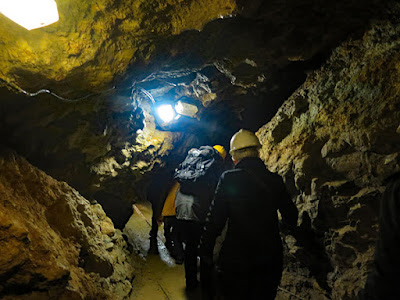 |
| The entrance to Temple Mine |
As a geologist, I like to go underground whenever I can and my trip to the Temple Mine in Matlock Bath, with the Sheffield U3A Geology Group, was my fourth time in a year. Apart from offering a viewpoint of a rock exposure that often can't be appreciated at the surface, it also provides an opportunity to practice my photographic skills although, having said that, I somehow managed to delete an excellent set of photos that I had taken the previous month in the magazine at Pontefract Castle, when the lighting had failed.
 |
| Starting the tour of Temple Mine with the Sheffield U3A Geology Group |
At the National Coal Mining Museum, no photos were allowed for safety reasons but, at Chislehurst Caves and during visits a few years ago to Treak Cliff Cavern, Peak Cavern and Mortimer's Hole with groups of Spanish students – using my old digital SLR - I came away with some good photographs and I looked forward to visiting Temple Mine.
 |
| A tunnel in Temple Mine |
To date, all of my visits to show caves/old mines have dwelled on the history and various tales that relate to them, and except for Creswell Crags, I would consider them to be very “commercial” and, like very many other tourist attractions in the UK, not very good value for money. Catering for the general tourist, especially children, business motives generally take precedence over their educational value and with the Earth Sciences having fallen out of favour with schools, universities and museums, it isn't really very surprising to find this happening.
 |
| A general view of Temple Mine |
Having professional interests in Geoheritage and its associated tourist industry, my expectations are probably way too high and I have yet to visit a show cave without feeling somewhat disappointed; however, even though I usually end up missing half of what is said by the guide by hanging back from the group to take photos, I usually leave with a little bit more geological knowledge than I had before – not forgetting a great sense of gratitude that I have never had to put up with such working conditions.
 |
| A general view of Temple Mine |
At Temple Mine, which was mined for lead and fluorspar like other show caverns at the Heights of Abraham nearby, the Carboniferous limestone seen underground has a distinctly yellow/brown tinge, unlike nearly every other outcrop of limestone I had encountered when surveying the Regionally Important Geological Sites (RIGS) in the Peak District National Park 20 years previously, which usually occurs as various shades of grey.
 |
| Various drills |
Although there was simply no opportunity to examine it closely, and I didn't think to retrieve a small specimen, I assume that this is the product of the original limestone being dolomitised – based on the colour of the dolomitic limestones that I have seen in South Yorkshire.
 |
| A general view of weathered basalt and overlying clay |
The particular highlight for me, which I am sure that I wouldn't have noticed without it being pointed out by the guide was the occurrence of a sticky yellow/brown bentonite rich clay, which is the product of the weathering of a layer of the Lower Matlock Lava Member, which is interbedded with the limestone here in the mine.
 |
| The guide highlights an example of bentonite rich clay |
Where this formation occurs in the region around Matlock Bath and Bonsall Moor, the basalt - and the overlying tuff which is often associated with it - is weathered down to this clay in varying degrees and, although I wasn't able to inspect this example very closely, its origin as a lava flow can often be determined by the presence of amygdales.

No comments:
Post a Comment